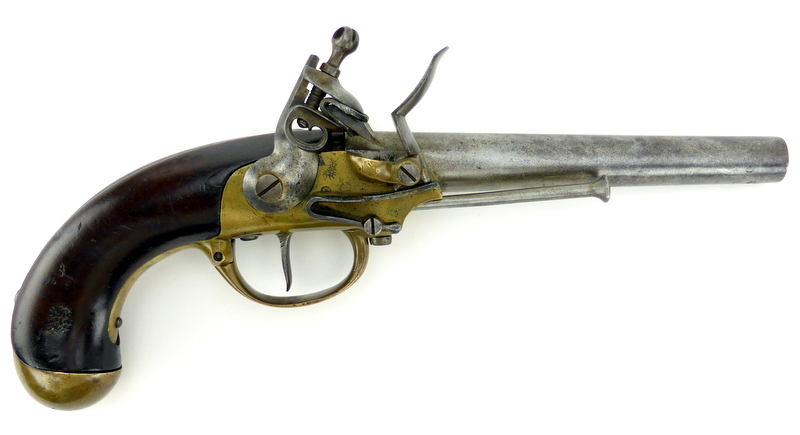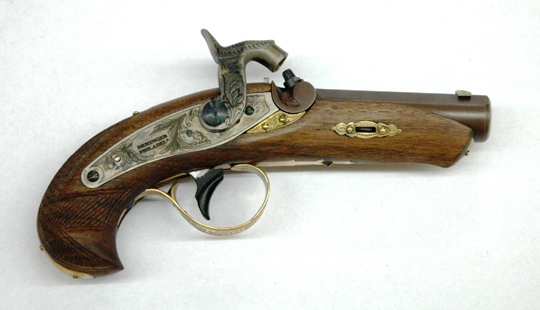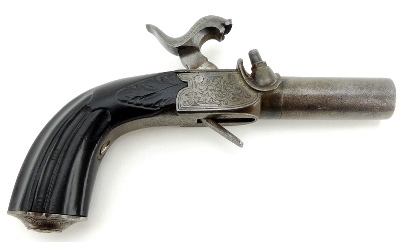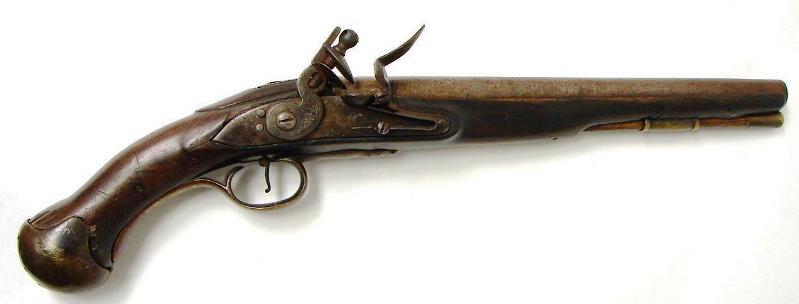“Over all, he wore a capote or a buffalo robe pulled in at the waist by a leather belt, into which were thrust a piratical collection of side arms - pistols, scalping knifes and hatchets –.”
Gerald Rawling - The Pathfinders
Thousands of pistols were imported to America during the 250 year era of the trade gun. They were always ordered in pairs but the merchants may have sold them individually. American gun makers including the Hawken brothers also built and sold pistols. Pistols were primarily used as close distance personal defense weapons. They were carried tucked into a leather belt, a sash, pocket, or holster. Early pistols were flintlock smoothbores typically loaded with shot. Rifled barrels and percussion locks came into common use during the 1830’s.
The typical belt pistol of the mountain men had a 9-10 inch barrel and weighed about 2 ½ pounds. This original example is of the percussion type common during the 1830’s.

Dueling pistols were usually loaded with a single ball and tended to be of smaller (.36 to .45) caliber. Many of them made their way into the mountains. This pair of original flintlock dueling pistols are 16 inches over all with 10 inch barrels.
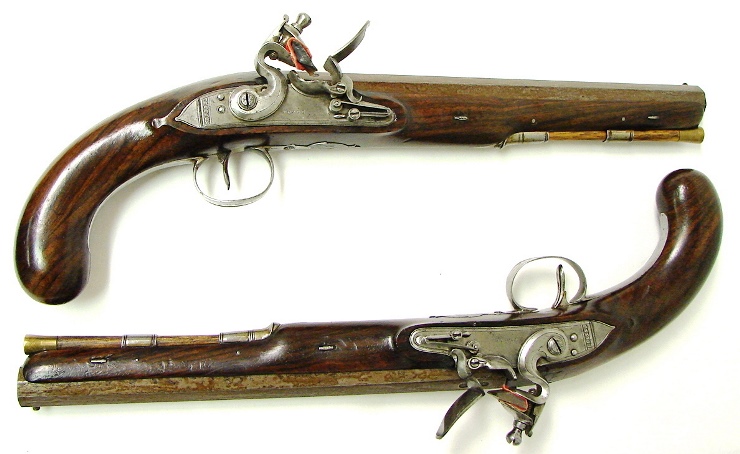
Here is a reproduction of an English dueling pistol, originally created by Charles Moore of London. It has a rifled barrel of .36 to .45 caliber, hooked breech, drum type percussion lock, walnut stock, brightly polished steel furniture, and single set trigger. Original examples of these pistols exist today and can still be purchased in cased sets.
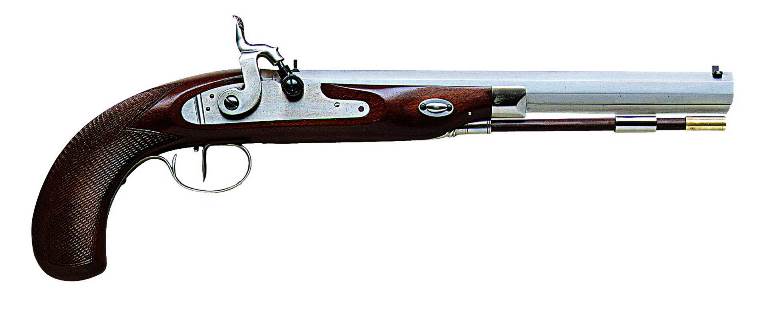
This is a replica of a Kentucky style flintlock pistol with a maple stock, rifle style sights, brass furniture, and a rifled barrel in .45 caliber.
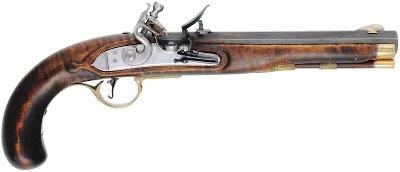
This replica Hawken pistol was patterned from an original example. It has a maple stock, iron furniture, percussion lock with patent breech, and a 9 inch riffled barrel in 54 caliber. It is interesting to note that the Hawken shop produced nearly as many pistols and double barreled shotguns as they did rifles. Original Hawken pistols and shotguns are quite rare today.
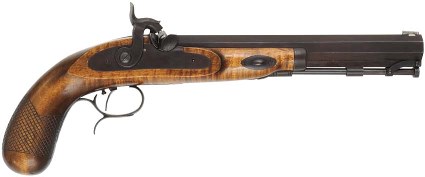
An early French flintlock pistol made in Charliville.
Queen Anne pistols are usually a breech-loading design known as a turn-off barrel. They first came in fashion in England during the reign of Anne, Queen of Great Brittan hence the name. Though made in all sizes up to carbine, they were usually made in the size range known as coat pocket pistols or coat pistols, easy to conceal on one's person. A small version, known as a Toby or muff pistol could be easily concealed in a smaller pocket or a ladies hand warmer muff.
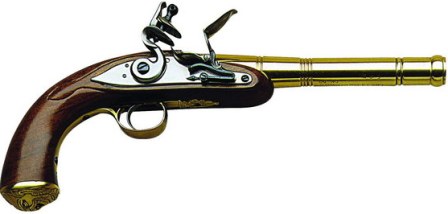
Henry Deringer built small pocket sized percussion pistols of about .45 caliber with barrels 3 inches long, an overall length of 7 to 8 inches, a back action percussion lock and patent breech. These little Deringer built pistols were immensely popular. Often copied by other gun makers who sometimes marked them with a slightly different spelling of the Deringer name. Today just about any small single or double barrel pistol is known as a “Derringer” (spelled with two r‘s). One particular pistol of this type was made quite infamous when John Wilkes Booth used it to assassinate President Lincoln.
Small screw barrel pistols such as the two pictured here fit easily into a pocket or a ladies hand warming muff. The barrel is removed from the gun and loaded from the breech end. Earlier flint lock versions of these type guns were also available. These small caliber, easy to carry pistols were very popular.
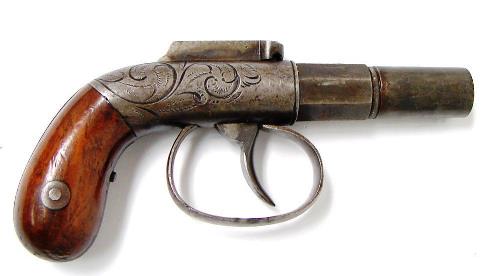
The pepper-box revolver (so named because of its resemblance to the household pepper grinder) is a multiple barrel repeating firearm which has three or more barrels grouped around a central axis. This system existed as early as the 15th century and has been used in every type of ignition system; matchlock, wheel lock, flintlock, percussion, pin fire, rim fire, and center fire.

Most percussion pepperboxes have a circular flange around the rear of the cylinder to prevent the capped nipples being accidentally fired if the gun were to be struck while in a pocket, or dropped. This percussion type of revolving pistol was popular in North America from 1830 until the American Civil War when it was essentially replaced by Colt revolvers. It is very likely that a few of these saw use during the fur trade.
Dragoon or Horse pistols were issued to mounted troops and carried in holsters attached to the saddle. These were typically of large gauge, smoothbore, with barrels 12 inches long and about 20 inches overall length. This dragoon pistol, originally flintlock has been converted to percussion.

The Navy also issued pistols of similar types for use aboard ships. Dragoons and Naval pistols may have seen use in the early years of the fur trade.
Many different types of pistols were available during the rendezvous period. That the mountain men carried pistols is well documented. However, there doesn’t seem to be a particular type or style of pistol which was developed specifically for the fur trade as was the case with smoothbore Trade Guns and Trade Rifles.
While it is true that the Colt Paterson Revolver was invented before the end of the rendezvous period there is no evidence that they were known to the mountain men until after 1840. This is probably because the early Colt pistols were made in limited numbers. (Only 500 were manufactured circa 1837-1838) Those first Colt revolvers were small pocket size five shot revolvers with barrels of 3 inches length in .28 caliber. They were not a huge success because they were underpowered for self-protection and tended to break. It wasn’t until 1843 when the larger No. 5 Holster Model in .36 caliber (only 1,000 of these were produced) made its way via the Texas Navy into the hands of the Texas Rangers that the Colt Paterson Revolver gained any notoriety. Regardless of the desires of some re-enactors to make it so, there is no evidence the Paterson Revolver ever made its way to a rendezvous.

